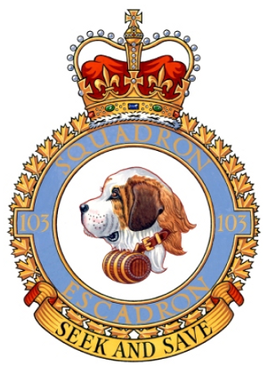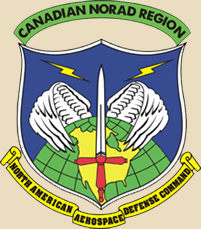Operation SUPPORT is the name given to Canadian Forces activities directly after the terrorist attacks of September 11, 2001. The CF had two immediate goals: to provide support for stranded aircrew and passengers from diverted commercial flights, and to increase emergency preparedness. Transport Canada called their operation Yellow Ribbon.
Canadian Forces Base Borden, formerly RCAF Station Borden, is a large Canadian Forces base located in Ontario. The historic birthplace of the Royal Canadian Air Force, CFB Borden is home to the largest training wing in the Canadian Armed Forces. The base is run by Canadian Forces Support Training Group (CFSTG) and reports to the Canadian Defence Academy (CDA) in Kingston.

Canadian Forces Base Goose Bay, commonly referred to as CFB Goose Bay, is a Canadian Forces Base located in the municipality of Happy Valley-Goose Bay in the province of Newfoundland and Labrador. It is operated as an air force base by the Royal Canadian Air Force (RCAF). Its primary RCAF lodger unit is 5 Wing, commonly referred to as 5 Wing Goose Bay.

The Canadian Forces Military Police provide police, security and operational support services to the Canadian Armed Forces (CAF) and the Department of National Defence (DND) worldwide.

Canadian Forces Base Greenwood, or CFB Greenwood, is a Canadian Forces Base located 1.5 nautical miles east of Greenwood, Nova Scotia. It is primarily operated as an air force base by the Royal Canadian Air Force and is one of two bases in the country using the CP-140 Aurora and CP-140A Arcturus anti-submarine/maritime patrol and surveillance aircraft. Its primary RCAF lodger unit is 14 Wing, commonly referred to as 14 Wing Greenwood.

103 Search and Rescue Squadron of the Royal Canadian Air Force is a search and rescue unit based at 9 Wing Gander on the Canadian island of Newfoundland. The squadron is responsible for a large area covering the offshore waters of Canada's Exclusive Economic Zone in the Atlantic Ocean and inland areas in the Maritimes, Newfoundland and Labrador, and parts of Eastern Quebec. The squadron operates three AgustaWestland CH-149 Cormorant helicopters.

The National Search and Rescue Program (NSP) is the name given by the Government of Canada to the collective search and rescue (SAR) activities in Canada. Until 2015, the NSP was administered by the National Search and Rescue Secretariat (NSS).

Canadian Forces Station Leitrim, also referred to as CFS Leitrim, is a Canadian Forces Station located in the neighbourhood of Leitrim in Ottawa, Ontario. It is concerned with the interception, decrypting and processing of communication for the Communications Security Establishment and the Canadian Forces, and forms part of the ECHELON system.

Canadian Forces Base Gander, is a Canadian Forces base located in Gander, Newfoundland and Labrador. It is operated as an air force base by the Royal Canadian Air Force and is home to search and rescue operations that cover a vast swath of the western North Atlantic and southern Arctic and a Canadian Coastal Radar station amongst other things. It is home to 9 Wing Gander.

Canadian Forces Base Winnipeg is a Royal Canadian Air Force base located within the City of Winnipeg, Manitoba. Co-located at the Winnipeg James Armstrong Richardson International Airport, CFB Winnipeg is home to many flight operations support divisions, as well as several training schools. Its primary RCAF lodger unit is 17 Wing, commonly referred to as 17 Wing Winnipeg.
Expenditures by federal and provincial organizations on scientific research and development accounted for about 10% of all such spending in Canada in 2006. These organizations are active in natural and social science research, engineering research, industrial research and medical research.

Northeast Air Command (NEAC) was a Major Command of the United States Air Force, responsible for the operation and defense of air bases in Greenland, Labrador, and Newfoundland. It was formed in 1950 from the facilities of the United States established during World War II in eastern Canada, Newfoundland and Greenland. It was discontinued in 1957.
The Canadian Forces Housing Agency is a special operating agency that manages military housing on behalf of the Canadian Department of National Defence for members of the Canadian Armed Forces and their families located on wings and bases.

The Joint Rescue Coordination Centre Halifax is a rescue coordination centre operated by the Royal Canadian Air Force (RCAF) and the Canadian Coast Guard (CCG).
Canadian Forces Station Sydney, also known as CFS Sydney, is a former Canadian Forces Station located in the community of Lingan Road, Nova Scotia.
RCAF Station St. Margarets is a former Royal Canadian Air Force station and later a Canadian Forces detachment located in the community of St. Margarets, New Brunswick.
The following is a hierarchical outline for the Canadian Armed Forces at the end of the Cold War. It is intended to convey the connections and relationships between units and formations.
Canadian Forces Station Moisie, also known as CFS Moisie, is a former Canadian Forces Station located in the community of Moisie, Quebec.











